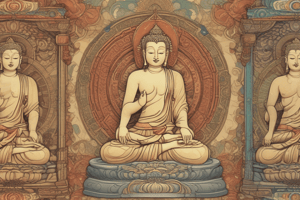Podcast
Questions and Answers
What did Buddha teach about giving joy and sorrow to others?
What did Buddha teach about giving joy and sorrow to others?
According to Buddha's teachings, how does negative action affect individuals?
According to Buddha's teachings, how does negative action affect individuals?
What analogy did Buddha use to explain the creation of the world and the cycle of actions?
What analogy did Buddha use to explain the creation of the world and the cycle of actions?
How did Buddha suggest helping a hungry and poor man instead of stealing from him?
How did Buddha suggest helping a hungry and poor man instead of stealing from him?
Flashcards are hidden until you start studying
Study Notes
- Buddha spoke to his disciples about the consequences of giving joy and sorrow to others.
- When we give joy to others, they return joy in large quantities and come back to us.
- When we give sorrow to others, they also return sorrow in large quantities and come back to us.
- Buddha explained that the world we live in has been created from a single seed, just like a tree that grows from a seed and bears fruit which then becomes new seeds, leading to the growth of more trees.
- When we give sorrow to others, it first takes root in our own minds and then manifests in the physical world when we interact with them.
- Buddha used the example of a hungry and poor man who needed money to buy food for his family. Instead of stealing his money, Buddha suggested that they should help him in other ways.
- The thought of stealing from the poor man caused distress in Buddha's mind, and even if he had managed to do so, it would not have brought him any real joy.
- Buddha warned that negative actions, even if done unintentionally, will bring back negative consequences in large quantities.
- Buddha advised his disciples to focus on their own actions and think deeply about them before acting, as their actions have the power to bring either joy or sorrow to themselves and others.
- The law of cause and effect, as described in Buddha's teachings, is a complex phenomenon that can lead to a chain reaction of joy or sorrow, depending on our actions.
Studying That Suits You
Use AI to generate personalized quizzes and flashcards to suit your learning preferences.



